In a momentous event that reverberated through the hearts of millions, the grand Ram Temple in Ayodhya was unveiled on January 22, 2024, marking the culmination of a centuries-old aspiration and serving as a beacon of unity for the nation. The Pran Pratishtha ceremony, graced by Prime Minister Narendra Modi and attended by thousands, was a spectacle of devotion and collective celebration.
The foundation of the Ram Temple rests on the rich tapestry of India’s cultural and religious heritage. For centuries, the site in Ayodhya held profound significance, believed to be the birthplace of Lord Ram. The construction of the temple is not merely an architectural feat but a testament to the resilience of the Indian spirit, overcoming historical complexities.
Prime Minister’s Address
Prime Minister Modi, addressing the gathering, emphasized the historical sacrifices and patience that led to this momentous occasion. “After centuries of unprecedented patience, countless sacrifices, renunciations, and penances, our Prabhu Ram has come,” he remarked. His words echoed the sentiment that January 22, 2024, is not just a date on the calendar but the dawn of a new era.
The moment of consecrating Ram Lalla’s life in Ayodhya Dham stirred deep emotions, as expressed by Prime Minister Narendra Modi in a tweet. “The extraordinary moment of the consecration of Ram Lalla’s life in Ayodhya Dham is deeply moving. It is my great pleasure to be part of this divine program. Hail Siya Ram!” Modi shared his sentiments, portraying personal involvement in the spiritual proceedings, going beyond political leadership.
As the ceremony concluded, Prime Minister Modi displayed reverence by prostrating himself before the idol, symbolizing the profound significance of the occasion, a gesture that extended beyond politics to convey a deep spiritual connection.
The Prime Minister’s itinerary also encompassed a visit to Kuber Tila, where he engaged with workers involved in the temple’s construction, acknowledging their vital role in this historic project and showered rose petals to express gratitude for their unwavering dedication and commitment to the monumental endeavor.
Unveiling of Ram Lalla Idol
The centerpiece of the ceremony was the unveiling of the “Ram Lalla” idol, a moment of deep reverence for the devotees present. PM Modi, performing the ‘aarti’ and leading the rituals, underscored the significance of the deity transitioning from a tent to the grand temple. The symbolism was profound, signifying the end of an era and the beginning of a new chapter in India’s spiritual journey.

Diverse Attendees
The ceremony was attended by over 8,000 guests, including RSS Chief Mohan Bhagwat, Uttar Pradesh Governor Anandiben Patel, and Chief Minister Yogi Adityanath. The presence of diverse representatives from major spiritual and religious sects underscored the inclusivity of the event. People from various walks of life, including tribal communities, showcased the widespread support for this historic moment.
Actively participating in the ‘pran pratishtha’ rituals alongside dignitaries like Uttar Pradesh Governor Anandiben Patel, Chief Minister Yogi Adityanath, and RSS Chief Mohan Bhagwat, Modi proceeded to address a diverse gathering of about 8,000 individuals, including seers and contributors to the Ram Janmabhoomi movement, as well as notable figures from entertainment, sports, and industry.
While senior BJP leaders opted for live streaming, notable Opposition figures chose to skip the event. However, Himachal Pradesh Minister Vikramaditya Singh, son of state Congress chief Pratibha Singh, broke the trend by attending.
Several BJP-led states declared the day a holiday, allowing people to witness the ceremony on TV and engage in local temple events.
The ceremony featured a devotional “Mangal Dhwani” with fifty traditional musical instruments, orchestrated by Ayodhya’s celebrated poet Yatindra Mishra and supported by New Delhi’s Sangeet Natak Akademi. This grand musical rendition included instruments like pakhawaj, flute, dholak, veena, algoja, sundari, mardala, santoor, pung, nagada, kali, and tambura, creating a spiritually resonating atmosphere.
Air Force’s Floral Tribute
As the idol of Ram Lalla was unveiled, Indian Air Force choppers showered flower petals over the Ram Janmabhoomi Temple premises, symbolizing a gesture of reverence and celebration from the nation.
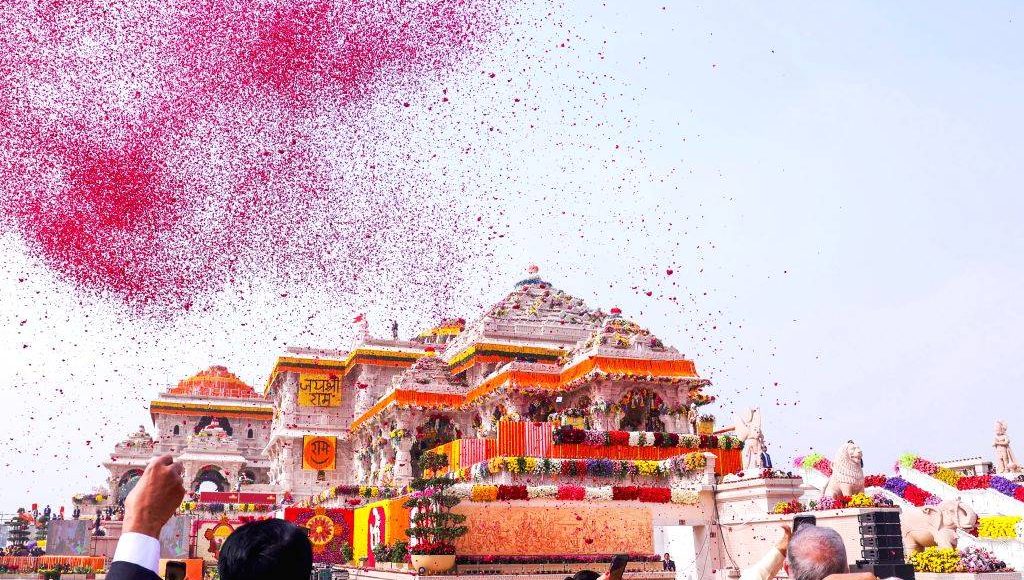
Architectural Marvel and Spiritual Hub
Ayodhya welcomes a new landmark, the majestic Ram temple, standing as a testament to both structural and spiritual excellence. Crafted from elegant sandstones sourced from Rajasthan’s Bansi Paharpur area, the sprawling three-storey temple, built in the traditional Nagara style, reaches 380 feet in length, 250 feet in width, and 161 feet in height. The construction, a result of collective wisdom, overcame engineering challenges with an artificial foundation.
The temple’s intricate design includes images of Lord Hanuman, deities, peacocks, and flower patterns carved onto the stones, providing a divine aura. Surrounding the grand temple is a 14-feet wide percota periphery, a unique feature more commonly found in south Indian temples. Ornate statues of elephants, lions, Lord Hanuman, and Garuda grace the main entrance, all carved from Bansi Paharpur sandstone.
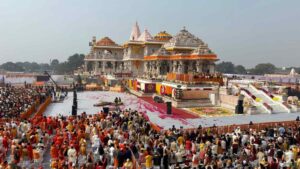
The complex, dedicated to self-reliance, features its own sewage and water treatment plants, a fire brigade post, and a dedicated power line. Approximately 70% of the 70-acre compound is designated as a green area, preserving about 600 existing trees. The green belt includes dense portions, creating an eco-friendly environment within the complex.
Unity in Diversity: Chief Imam Attends Ceremony
The Pran Pratishtha ceremony emphasized the unity in diversity that defines India. Representatives from various religious backgrounds and communities came together to witness the historic moment. The temple’s construction, once thought to “set off a firestorm,” turned out to be a symbol of peace, patience, and harmony in the country.
In a remarkable display of unity and inclusivity, Dr. Imam Umer Ahmed Ilyasi, Chief Imam of the All India Imam Organization, participated in the ‘Pran Pratishtha’ ceremony at Ayodhya’s Ram Temple. Expressing a vision of a new India, he emphasized that humanity is the primary religion, and for him, the nation comes first. This gesture underscores the evolving narrative of unity in diversity, transcending religious boundaries and embracing a shared sense of national pride.
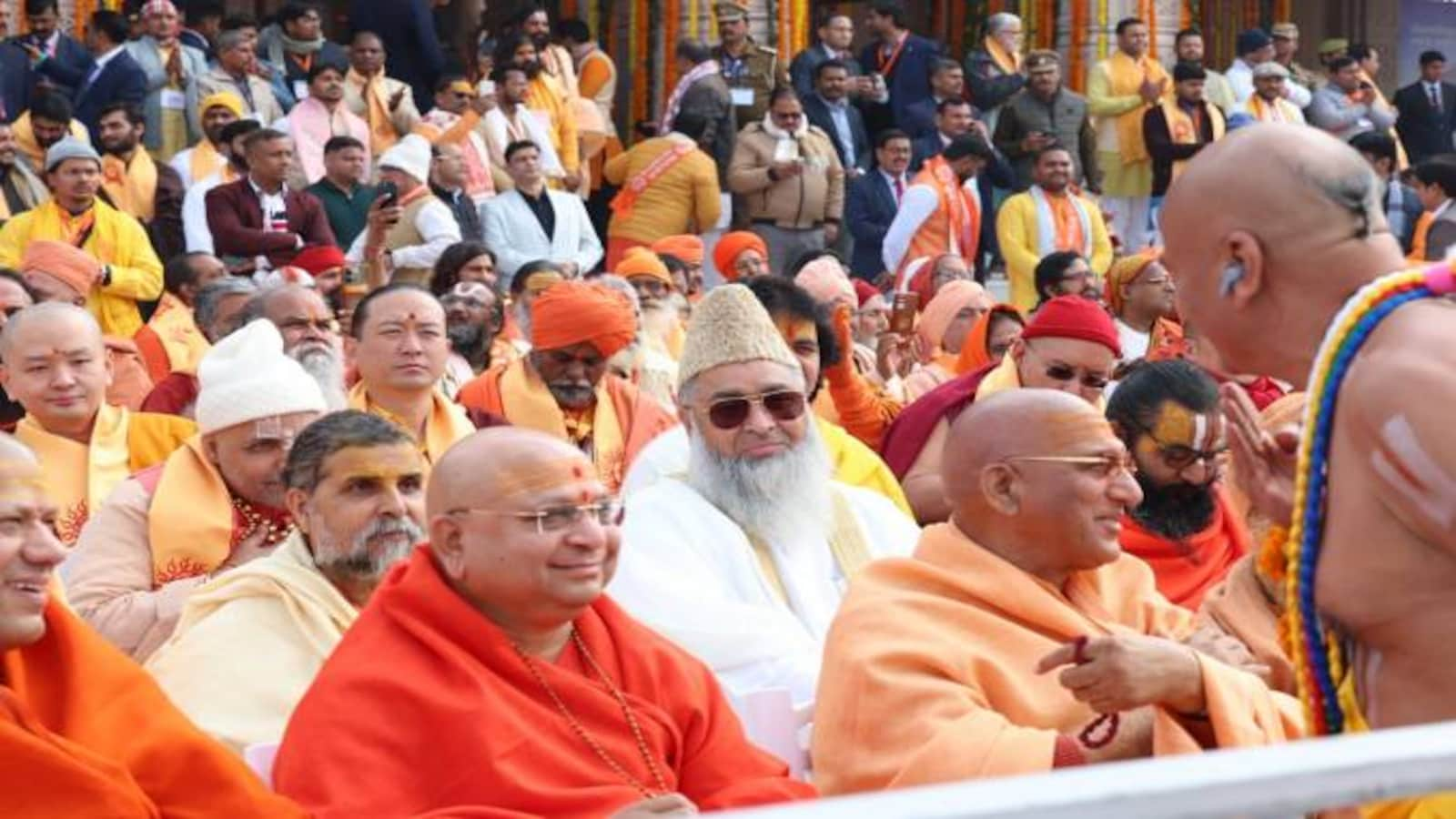
Symbolic Saffron Gift
Kashmiri Muslims gifted 2 kg of saffron for the Pran Pratishtha ceremony at Ayodhya’s Ram Temple, symbolizing unity and shared reverence for the Hindu deity Ram. Ashok Bhan, Chairman of the Kashmir (Policy & Strategy) Group, praised this cross-cultural gesture, emphasizing the inclusive nature of the Ramayana’s teachings.
As the grand ceremony unfolds on January 22, 2024, and the temple opens for public ‘darshan’ from January 23, contributions, including the saffron gift, enhance the sacred atmosphere. Bhan highlighted the significance of a meeting between Kashmiri Muslims and Vishwa Hindu Parishad president Alok Kumar, underscoring mutual respect despite religious differences. This symbolic gift adds to the narrative of Ayodhya’s new landmark, blending structural and spiritual elements with dedication to the Hindu deity Ram.
“The narrative of Rama’s incarnation as an embodiment of God in human form, per the Ramayana, resonates with collective consciousness. Enriched with cultural expressions, the ancient legends of Rama shape Vaishnavism’s core and echo in Jainism, Buddhism, and Sikhism, showcasing enduring tales across diverse spiritual traditions,” he stated.
“Shri Ram’s stay, marked by enchanting anecdotes, resonates deeply with Kashmiri cultural heritage. Legend holds that during his exile, Shri Ram sought solace in Kashmir’s serene meadows, leaving an indelible mark on the land. The gift of saffron, harmoniously shared among faiths, symbolizes cultural harmony, weaving India’s rich heritage and celebrating unity in diversity. As the grand Pran Pratishtha ceremony unfolds in Ayodhya, Kashmir’s saffron gift becomes a powerful symbol, connecting historical anecdotes of Shri Ram with present-day expressions of unity and respect among diverse communities,” he emphasized.
Kashmir Temples Reverberate with Special Prayers, Marking Ram Temple Consecration
In a moving display of unity and devotion, several temples in Kashmir, including the revered Shankaracharya temple, hosted special prayers on Monday to commemorate the consecration of the Ram temple in Ayodhya.
Devotees, comprising the minuscule Hindu population and tourists, gathered at the Shankaracharya temple on Zabarwan hills to partake in the special prayers organized for this historic occasion. The rituals were followed by a langar, extending communal bonding among attendees.
Similarly, special prayers adorned the Hanuman temple on the banks of Jhelum river in Amirakadal, with elaborate decorations enhancing the festive atmosphere in acknowledgment of the Ram temple consecration.
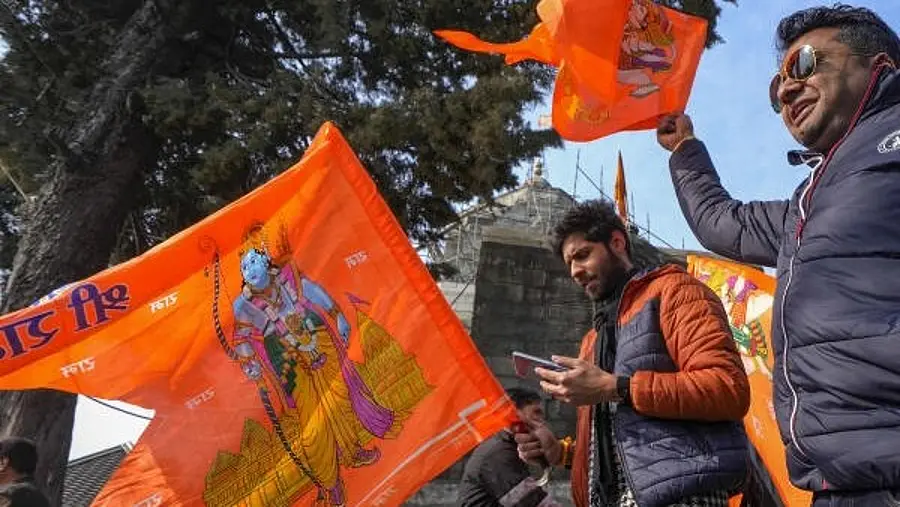
In Anantnag district, a havan at the Sun temple in Mattan echoed prayers for the restoration of complete normalcy in Kashmir. The organizers expressed a heartfelt wish for brotherhood and communal harmony to prevail, reminiscent of the times before 1990.
A special prayer session unfolded at the historic Ghanta Ghar in Lal Chowk area, further amplifying the spiritual significance of the event.
Thousands of lamps illuminated temples across Kashmir, casting a radiant glow in celebration of the consecration of the Ram temple in Ayodhya. The fervent prayers and luminous displays affirmed the timeless spirit of faith and unity in the region, commemorating this historic milestone.
International Attention
The grandeur of the event captured the attention of the international community, with global media covering the Pran Pratishtha ceremony extensively. The peaceful culmination of a long-standing issue showcased India’s commitment to resolving historical disputes through dialogue and consensus.
In a spectacular display of unity, the global Hindu diaspora celebrated the consecration of Ayodhya’s Ram Temple on January 22. International fervor echoed through various nations:
Mauritius: Temples illuminated with ‘diyas,’ resonating with Ramayan Path; Prime Minister Jugnauth graced cultural festivities.
United States: Live broadcast at 300 locations, including Times Square; Over 40 billboards showcased the grand event across 10 states.
United Kingdom: Streets reverberated with car rallies; Live Streaming united the UK Hindu community at 100+ locations.
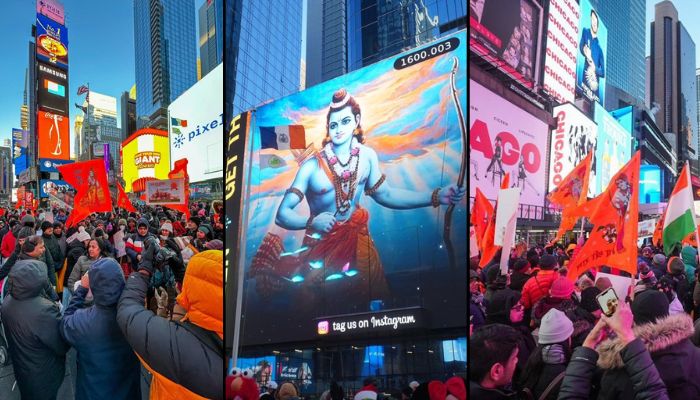
France: Grand Rath Yatra weaved through significant landmarks, culminating at the Eiffel Tower; elaborate rituals and cultural showcases enchanted participants.
Australia: Car rallies roared through major cities; Livestreamed celebrations at temples brought Australians together in joyous anticipation.
Canada: Nationwide livestreaming united communities; Oakville and Brampton declared ‘Ayodhya Ram Mandir Day,’ recognizing the cultural and historical significance.
As the global Hindu community came together, the consecration marked the culmination of a centuries-old dream. Prime Minister Narendra Modi presided over the historic ceremony, symbolizing a momentous chapter in the cultural and religious history of India.
Economic Impact
Apart from its cultural and religious significance, the construction of the Ram Temple holds economic implications. The project generated employment opportunities, stimulated local economies, and contributed to the growth of the construction sector. The influx of tourists and devotees is expected to boost the local economy in Ayodhya.
Future Prospects
The completion of the Ram Temple represents a historical juncture, but it also marked the beginning of a new era for Ayodhya. As pilgrims from across the country and the world made their way to seek blessings at the temple, Ayodhya became a major religious and cultural hub, attracting tourism and fostering economic growth.
The unveiling of the Ram Temple in Ayodhya stands as a symbol of faith, unity, and the collective spirit of the Indian people. The journey from the tent to the grand temple signifies not just the construction of a physical structure but the transformation of a centuries-old dream into reality. As the nation rejoiced in this historic moment, the Ram Temple continues to resonate as a testament to India’s rich cultural heritage and its unwavering commitment to unity in diversity.


Comments are closed.